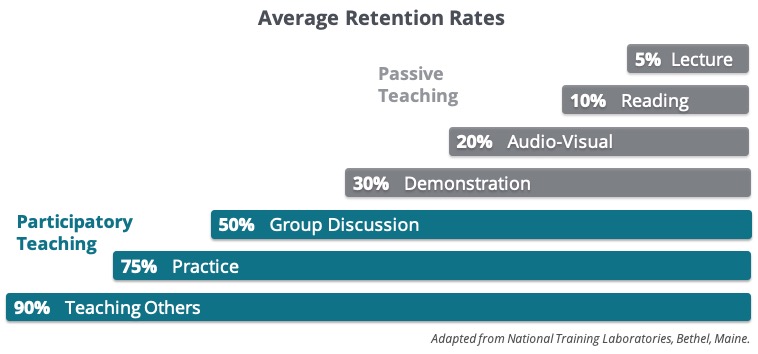Advancing Proficiency Through Sustainable Learning
Sustainable learning happens through exposure to new information or skills, followed by consistent reinforcement.
Over the years, many companies have come to consider ‘training’ as synonymous with ‘proficiency’ and nothing is farther from the truth. Sustainable learning, or proficiency, happens through exposure to new information or skills, followed by consistent reinforcement, so the learner practices and becomes adept in using it.
The concept of training has long been a maligned term in corporate America; it conjures up images of employees reluctantly pulled away from their day jobs and sequestered in a windowless conference room only to return exhausted and overwhelmed. In the meantime, emails and (more) to-dos piled up while they were away, so the training materials find a home in a desk drawer or on a shelf never to be touched again. For decades that scenario has been a standard operating procedure, hence “training” got a bad reputation. It appeared the time invested in the training didn’t move the needle the way management and leadership wanted.
“Tell me and I forget, teach me and I may remember, involve me and I learn.”
—Chinese proverb
In more recent years, the corporate world began capitalizing on new technology and pivoted to tactics such as online learning, microlearning, and gamification—yet these investments still often resulted in lukewarm results.
In this point of view, we discuss the fundamental issues—and implications—associated with traditional training methods and outline Parker Avery’s approach to creating an environment that supports the ultimate goal of meaningful and sustainable learning.
Understanding How Adults Learn
First, keep this phrase top of mind: training does not equal sustainable learning. After investing millions of dollars and thousands of hours in implementing new technology, redesigning an organization, or reengineering business processes, a slight 12 to 20 hours are typically dedicated to the education of the employees. Adult learners are hands-on creatures. As such, listening to the most energetic facilitator or watching someone else do the new task does little to help an adult learn, let alone become proficient at the new skill. This mindset clashes with our instant-gratification society: we assume that as adults, we should figure it out and move on.
However, adults simply do not retain information after attending a training session without a well-crafted support plan in place. The entire concept of training must be re-framed. Because someone attends a few three-hour training sessions for a new system does not equate to proficiency in using the new system. Instead, what if the training session was poised as the ‘opening act’ for a new learner? It is their first exposure to the information, but it cannot stop there.
Many people know of the ‘learning pyramid,’which emphasizes the need for adults to engage in hands-on practice as well as teach others the new skill. To embed new knowledge in your organization, you need in-house experts who can guide and support others. It’s critical you own the expertise, because while the road to proficiency is a long one, it can be accelerated.

Several years ago, in his book “Outliers,”Malcolm Gladwell suggested it takes approximately 10,000 hours to become an expert at just about anything. This timeframe is a depressing thought for today’s fast-paced business environment: when you consider that one full-time equivalent (FTE) works approximately 1900 hours a year, Gladwell essentially says it takes five years for an employee to become skilled on a new business process or system. The good news is, while a catchy sound-bite, the 10,000-hour rule is decidedly flawed. However, it still takes more time than most think for team members to get up to speed. Much of this is due to how our memory and memory recall works.
Let’s take a moment to understand human recall because it informs how best to shape a retail training program:
Understanding how the human brain handles most information is critical in developing sustainable learning programs that result in long-term knowledge retention, skill maturity, and ultimately—expertise. In the next section, we will look at some key ways to do this.
Accelerating the Learning Curve
Memory retrieval improves when more senses are engaged in learning new information; hence, remember the learning pyramid discussed earlier. Ability, competence, and knowledge grow faster and deeper when a person is more involved and new skills are frequently practiced.
The Parker Avery Group focuses on building learning plans and programs rather than training for our clients. There are three components to our approach, and they encompass pre-, during, and post-learning. We call these components our ‘learning retention imperatives’ to help adult learners gain competency faster: share knowledge early (pre), engage the end-users’ managers (during), and reinforce the experience after the fact (post). Let’s take a deeper dive into what each of these means.
Share Knowledge Early
Start early and engage often; a new business process or system implementation is usually several months in the making. The organization’s members know the change is coming, but typically don’t know what to expect. This ‘unknown’ induces cognitive and emotional stress for employees, which slows down their ability to learn and retain information when the time finally comes because they are too caught up with unknown changes. Do not wait until the 11th hour to expose end-users to the ‘grand reveal.’
Create a strategic communication and training roadmap to excite and engage the audience early; think of it as a media kit. Build a compelling message and find multiple mediums and platforms to broadcast how employees will benefit from the initiative. Develop and communicate a credible learning program for the impacted employees and their leaders, so they know what to expect and when it’s coming. Consider workshops or seminars you can offer to prepare them for the new environment.
If the organization needs improved soft skills, offer change readiness workshops and team-building exercises. Conflict and tension are bound to happen, so consider a session focused on managing conflict or a negotiation
Engage Management
Top-down, middle-out, and bottom-up is our mantra for leading change, but the middle is where the magic happens. Sponsorship from senior leadership is key for a new training initiative, but middle-managers are critical to successful training and change programs. As Harvard Business Review (among others) discovered:
“Mid-level managers weren’t merely managing incremental change; they were leading it by working levers of power up, across and down in their organizations.”
Consider ways to involve all levels of the organization during training, but especially trainees’ immediate supervisors. Ensure the supervisor attends the event, or better yet, ask them to introduce the session(s) or participate in delivering the content.
As much as possible, try to include every level of the organization and hold management accountable for attendance and participation. Employees need to witness all levels rolling their sleeves up and making time to grow their skills.
Reinforce the Experience
This is where the investment in learning is maximized: consistent reinforcement and practice of new information and skills helps continue to shift the information from short-term to long-term memories. Training (or learning) plans should incorporate post-training activities and feedback mechanisms to uncover knowledge gaps and identify complementary as well as additional training opportunities.
Because adults use a multitude of different ways to obtain, absorb, and retain information, consider the following medium:
- Online videos that dive into more details of each new competency
- Printable, brief user guides for quick and easy reference
- Pamphlets circulated that explains the ‘making of’ new initiatives
- Podcasts to reinforce key components
- Interactive ‘trivia hours’ where learners team up and test their skills
- Weekly online micro-tests to gauge how well knowledge and proficiency is improving
- Quarterly or annual events to introduce new and refresh past information
In our experience, one of the best methods to ensure long-lasting proficiency is to develop a train-the-trainer (TtT) certification program, which builds in-house expertise. In any of these techniques, it is often useful to find inspiration from pop-culture such as reality TV or TV series, game shows, board games, and online games. However, a balance must be struck between incorporating the ‘fun’ with keeping the overall tone and content mature and professional. Adult learners need to be engaged, but they will quickly lose interest if the theme or tone is perceived as silly or nonessential. Above all, remember that when people repeatedly learn and recall information over a prolonged time frame, they are more likely to retain the information.
Final Word
It’s time to retire the word ‘training’ in a professional business setting. Adults are not trained—they are exposed to new information and skills on a continual basis. In today’s uber-connected, fast-paced environment, information needs to fight hard to win space in our memories. We all want results quickly, but these results must be sustainable and enhanced for the long term. Our sustainable learning imperatives will help accelerate your team’s learning and growth by providing the critical help new information needs to shift from short-to long-term memory—and gain true proficiency. This is the real essence of sustainable learning—and with enough time, practice, and reinforcement, learning turns into advanced proficiency.
You may also like





